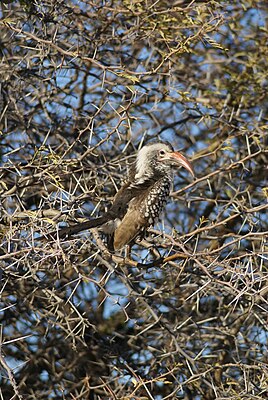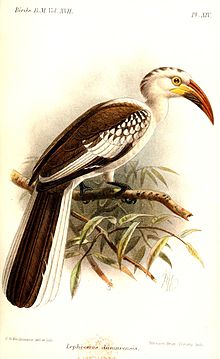Damara red-billed tooko
| Damara red-billed tooko | ||||||||||
|---|---|---|---|---|---|---|---|---|---|---|

Damara Red-beaked Toko, Etosha National Park |
||||||||||
| Systematics | ||||||||||
|
||||||||||
| Scientific name | ||||||||||
| Tockus damarensis | ||||||||||
| ( Shelley , 1888) |
The Damara hornbill ( Tockus damarensis ) is a bird art that the hornbills belongs (Bucerotidae) and in Namibia occurs. The Damara-Rotschnabeltoko was long considered a subspecies of the Rotschnabeltoko , but for some years it has been granted species status. It is slightly larger than the Red-billed Toko and its courtship behavior differs somewhat.
The stock situation of the Damara red-billed coconut was classified in the IUCN Red List of Threatened Species in 2016 as " Least Concern (LC) " = "not endangered".
features
The Damara-Rotschnabeltoko reaches a body length of up to 35 centimeters and is one of the smaller tokos. The male's beak is between 8.3 and 9.9 centimeters. The beak is slightly smaller in the females with 7.9 to 7.7 centimeters, but the difference in size is not as pronounced as in the red-beaked toko. Males weigh between 200 and 220 grams, the females weigh between 150 and 200 grams.
male
The males are dark gray on the crown and neck, the neck, forehead and face are white. The ear covers are not dashed gray, unlike the Red Schnabeltoko, but white. They are separated from the crown by a wide white eyelet. The back is soot-brown and becomes even darker towards the upper tail-covers. There is a white line drawing in the middle of the back. The two middle pairs of the total of 10 pairs of control springs are black, the remaining eight pairs are black at the base and then cross-banded in white and black. The underside of the body is white. The wings are black with white spots in the middle, the outer wings are black and also have white spots. The inner wings are almost completely white. The wing covers are soot-brown with large white spots in the middle, the feathers of the middle wing cover are almost completely white. The beak is red with a narrow yellow base. The lower bill is black from the base to almost the middle. A horn is almost completely absent, there is only a narrow elevation on the upper beak. The featherless orbital ring and the bare throat skin are flesh-colored. The eyes are brown, the legs and feet are sooty brown.
Females and young birds
The females resemble the males in body plumage, but are smaller overall. The beak is red, the lower beak is not half black as in the male, but has only a single black spot.
Young birds are colored like the adult birds, but their beak is much smaller and uniformly brown-yellow. Black markings on the beak are still completely missing. The eyes are initially gray, they only turn brown later.
voice
The calls of the Damara-Rotschnabeltoko are cackling kok sounds, which can occasionally be heard in sequence kok-kok-kok-kockok-kockok-kockok .
Distribution area and habitat
The Damara-Rotschnabeltoko occurs only in Namibia. They are represented in Damaraland , in the north and the central plateaus.
The Damara-Rotschnabeltoko inhabits open savannah, which is sparsely covered with thorn bushes. Compared to the closely related red-billed toko, it inhabits regions with less rainfall and also drinks in the mountains.
behavior
The diet consists of insects , fruits and seeds, which are mostly ingested on the ground. Fruits and invertebrates play a major role in the food spectrum, especially in summer. In winter it mainly takes up seeds. Dung beetles play an important role in the diet, and locusts, termites, ants and fly maggots are also eaten. They also eat small lizards, plunder the nests of bloodbeak weavers and red-bellied shrike , whose eggs and nestlings they eat. They also go to carrion.
Damara red-billed tokos usually come in pairs or small family groups. They defend a territory during the breeding season.
The entire breeding cycle from the closing of the breeding cavity by the female until the fledglings leave the fledglings lasts 65 to 99 days. Of this, 23 to 25 days are spent on incubating the eggs and 39 to 50 days for the nestling period. The female stays in the closed brood cavity for three to 24 days before the first egg-laying. It goes through moulting during the breeding cycle.
The female lays three to six eggs in a tree hole, which it closes with clay, manure and pulp. Only a one-inch-wide opening is left that is just big enough for the male to pass through food for the female and chicks. The laying interval between the individual eggs is one to six days, and the nestlings hatch accordingly asynchronously. To keep the cave clean, the droppings are thrown outside through the opening. If the chicks, together with the mother, become too big for the cave, the latter breaks the seal and leaves the cave. The nestlings then make the closure again and both parents feed the young.
literature
- W. Grummt , H. Strehlow (Ed.): Zoo animal keeping birds. Verlag Harri Deutsch, Frankfurt am Main 2009, ISBN 978-3-8171-1636-2 .
- Alan Kemp: The Hornbills - Bucerotiformes . Oxford University Press, Oxford 1995, ISBN 0-19-857729-X .
Web links
- Tockus damarensis in the endangered Red List species the IUCN 2014 Posted by: BirdLife International, 2014. Retrieved on 3 October 2016th
- Calls from the Damara red-beaked coconut on Xeno-Canto
Single receipts
- ↑ Tockus damarensis in the endangered Red List species the IUCN 2016 Posted by: BirdLife International, 2016. Retrieved on 9 October 2017th
- ↑ a b Kemp: The Hornbills - Bucerotiformes . P. 133.
- ↑ Kemp: The Hornbills - Bucerotiformes . P. 131.
- ↑ Calls of the Damara-Rotschnabeltokos on Xeno-Canto ( page no longer available , search in web archives ) Info: The link was automatically marked as defective. Please check the link according to the instructions and then remove this notice. , accessed October 3, 2016
- ↑ Kemp: The Hornbills - Bucerotiformes . P. 134.
